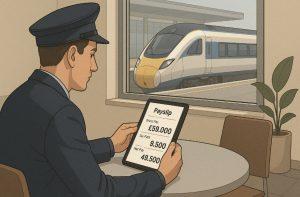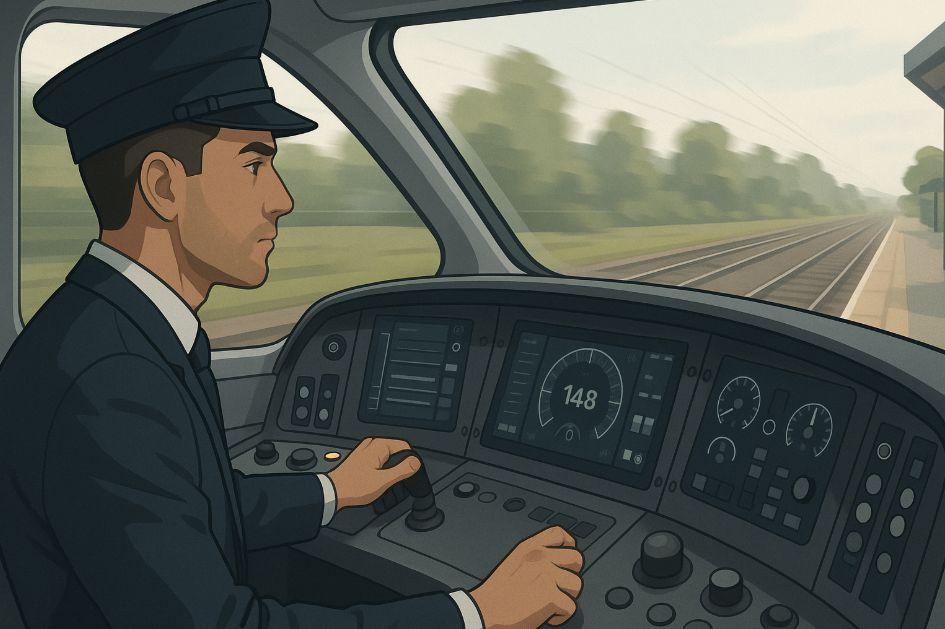Train driving continues to be one of the most stable and financially rewarding careers in the UK’s transport sector. With growing demand across passenger and freight services, salaries for train drivers have increased significantly in recent years. As of 2025, various factors such as location, operator, job role, and experience level all contribute to a dynamic and evolving pay landscape.
This guide breaks down the salary trends and expectations for train drivers in 2025, providing insights into how much professionals in the industry can expect to earn at different stages of their careers and within different rail companies.
What is the average train driver pay in the UK in 2025?

As of 2025, the average salary for a train driver in the UK is approximately £48,500 per year. This figure reflects an industry-wide increase, partly due to successful negotiations led by train driver unions like ASLEF, which recently secured a 15% wage bump in some regions.
Salaries generally fall within these ranges:
| Experience Level | Salary Range |
| Entry-Level (Newly Qualified) | £30,000 – £37,000 |
| Mid-Level (3–5 Years) | £40,000 – £55,000 |
| Senior/Experienced Driver | £55,000 – £65,000+ |
Pay often varies by region and operator, with London and urban rail drivers earning more due to higher living costs and traffic density.
How does train driver salary differ by experience level?
Entry-Level Salaries
Newly qualified train drivers typically start with a salary between £30,000 and £37,000. These roles are often filled through apprenticeships or training schemes offered by rail companies. The entry-level period usually lasts one to two years, during which drivers gain route knowledge and safety training.
Mid-Level and Experienced Drivers
As drivers gain more experience and responsibility, their salaries increase accordingly. Those with 3–5 years of experience often earn between £40,000 and £55,000, depending on the complexity of routes and shifts they manage. Experienced professionals who have operated on major lines or trained in multiple traction types can earn £60,000 or more, especially with overtime.
What roles exist within the train driving profession and how do they affect pay?
Passenger vs Freight Drivers
Passenger train drivers form the largest segment of the industry and their pay varies slightly depending on whether they operate local, regional, or long-distance routes. Freight drivers, on the other hand, often earn slightly more due to irregular shifts, longer hours, and night-time operations.
Specialist and Supervisory Roles
Advanced roles such as instructor drivers, who train new recruits, and compliance officers, who ensure safety standards, command premium salaries. Similarly, route assessors and senior operational staff tend to earn more due to the added responsibility and regulatory knowledge required.
How much do train drivers earn at different UK rail companies?

Salary Comparisons Across Operators
Salaries vary significantly by train operating company (TOC). Some of the highest-paying employers include Avanti West Coast, GWR, and London Underground. Operators based in metropolitan areas tend to offer higher base salaries to attract and retain talent in a more competitive labour market.
| Operator | Average Salary (2025) |
| Avanti West Coast | £60,000 – £67,000 |
| Great Western Railway | £56,000 – £64,000 |
| Southern Rail | £52,000 – £58,000 |
| London Underground (TfL) | £57,000 – £62,000 |
| Freightliner (Freight) | £55,000 – £63,000 |
| CrossCountry | £53,000 – £60,000 |
These salary bands can include overtime, performance bonuses, and shift premiums.
What are the highest-paying train driver jobs in 2025?
Train drivers working on high-speed rail services or in freight logistics are among the highest earners in 2025. These jobs often demand flexible schedules, extended travel distances, and advanced certification, but they are well compensated.
Specialist roles in the public sector are also rising in demand as the UK expands its rail infrastructure. Drivers involved in HS2 pre-launch operations or high-frequency metro systems are receiving salary offers exceeding £70,000, especially when overtime is factored in.
Do train drivers receive additional benefits beyond salary?
Financial and Lifestyle Benefits
In addition to their base pay, train drivers in the UK enjoy a wide range of benefits. These include:
- Defined benefit pension schemes
- Free or heavily discounted rail travel
- Annual leave packages exceeding statutory minimums
- Shift differentials and overtime pay
- Family travel perks with some operators
These non-wage benefits enhance the total compensation package and improve work-life balance.
What qualifications and training impact train driver earnings?

To become a train driver in the UK, candidates usually enter through a Level 3 Train Driver Apprenticeship or an in-house training programme provided by rail operators. Training includes classroom-based instruction, route learning, and supervised driving.
Those who invest in continuous professional development (CPD) and multi-route qualification can significantly boost their earnings. Advanced certifications for signal system handling and traction switching are particularly valued and often rewarded with higher pay.
What are the working conditions and how do they relate to pay?
Train drivers typically work irregular shifts, which may include nights, weekends, and bank holidays. These demanding schedules are taken into account in salary negotiations and union agreements.
Despite the challenges, the role offers structured work environments and clear progression pathways. Workload and performance are closely monitored, which ensures high safety standards but also demands strong focus and discipline from drivers.
Is train driving a financially secure long-term career in the UK?
Train driving is not only financially rewarding but also professionally stable. With rising passenger demand, increased freight logistics, and major rail infrastructure projects underway, the career offers excellent prospects for the future.
Career progression opportunities are also abundant. Drivers can move into training roles, operations management, or even policy and compliance positions within large rail organisations. Strong union representation ensures that wage growth and working conditions continue to evolve positively.
Is becoming a train driver in the UK a good career choice in 2025?

Strong Earning Potential
-
- Starting salaries range from £30,000 to £37,000.
- Experienced drivers earn £60,000+, especially with overtime and bonuses.
- Recent union-led wage increases have enhanced overall compensation.
High Job Security
-
- Rail industry continues to grow, with major projects like HS2 boosting demand.
- Driver roles are protected by strong union representation.
- Automation is limited in the UK, keeping human roles essential.
Government and Public Sector Support
-
- Rail investments have created more apprenticeships and training schemes.
- Publicly funded operators offer additional benefits and pensions.
Flexible Lifestyle Benefits
-
- Though shift-based, many enjoy structured working hours and extra leave.
- Early retirement is possible through rail industry pension schemes.
- Drivers often receive free or discounted travel for themselves and family.
Career Progression Opportunities
-
- Clear path to become Instructor Driver, Route Assessor, or Manager.
- Additional qualifications can lead to specialised roles with higher pay.
Ideal for UK Career Seekers
-
- Suitable for school leavers, military leavers, or career changers.
- A stable, respected career path with long-term financial rewards.
What is the work-life balance like for train drivers in the UK?

Shift Patterns and Scheduling
Train drivers typically work on rotational shift patterns, which include early mornings, late evenings, weekends, and bank holidays. While these hours can be demanding, they are usually planned well in advance, allowing drivers to organise their personal time effectively. Some rail companies offer four-day workweeks or compressed hours, providing extended periods of rest between shifts.
Paid Leave and Holidays
Most train operators in the UK provide 25 to 30 days of annual leave, in addition to public holidays. This is above the statutory minimum and helps promote a healthy balance between work and rest. Some operators also allow shift swapping or additional leave days based on years of service, enhancing flexibility for long-term employees.
Mental and Physical Demands
While train driving is not physically strenuous, it does require strong concentration, particularly during long routes or high-frequency services. Companies invest in wellbeing support, such as access to mental health services and fatigue management programmes, ensuring drivers are fit to perform safely and comfortably.
Overall Lifestyle Considerations
Despite the non-traditional hours, many drivers appreciate the structured routines, job autonomy, and financial rewards that come with the role. For those who value consistency, long-term benefits, and a respected position within the transport industry, train driving offers a balanced and fulfilling lifestyle.
Conclusion
In 2025, the landscape for train driver pay in the UK is highly competitive and continues to evolve. With average salaries nearing £50,000 and top earners making over £65,000, train driving remains a lucrative and respected profession. Add to this the benefits, structured career development, and long-term security, and it’s clear that becoming a train driver is more than just a job it’s a solid career path with impressive financial rewards.
FAQs About Train Driver Pay
What’s the minimum age to become a train driver in the UK?
The minimum legal age is 20, but most operators require applicants to be at least 21 when beginning full training due to safety regulations.
Can train drivers earn bonuses?
Yes, some companies offer performance-related bonuses or retention incentives, especially during staff shortages or peak seasons.
How does location affect a train driver’s salary?
Salaries in London and the South East are generally higher to compensate for living costs and higher service demands.
Is overtime common for train drivers?
Overtime is quite common, particularly during holidays and staff shortages, and is paid at higher hourly rates.
How long does it take to become a qualified train driver?
Training typically takes between 12 and 18 months, depending on the route complexity and company.
Are there part-time train driving jobs?
Part-time roles are rare but may exist in depots









Leave feedback about this